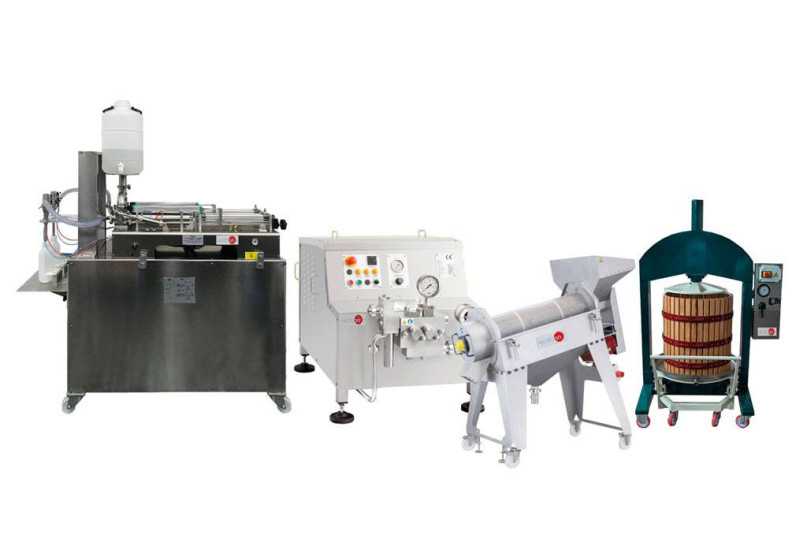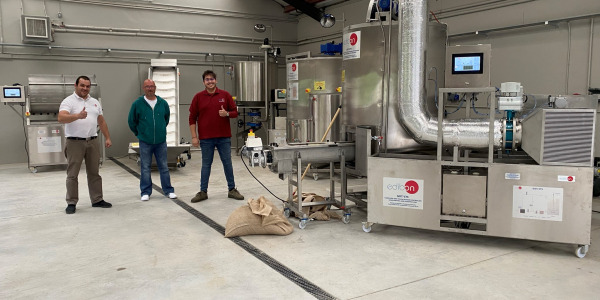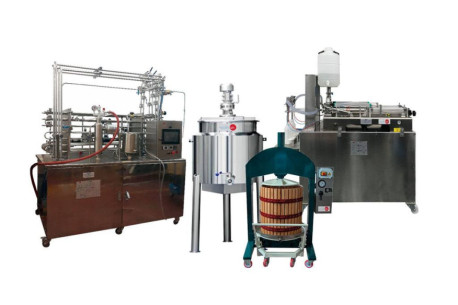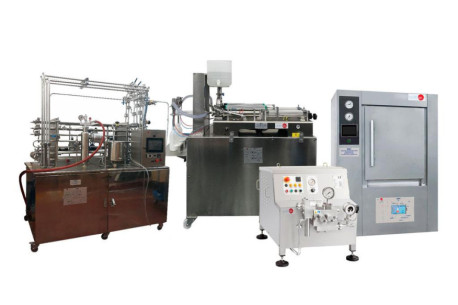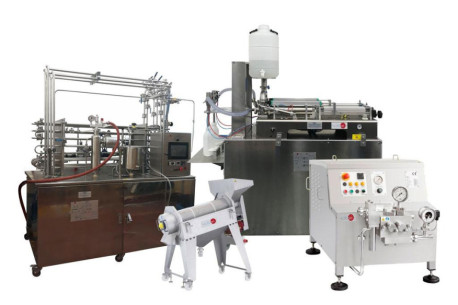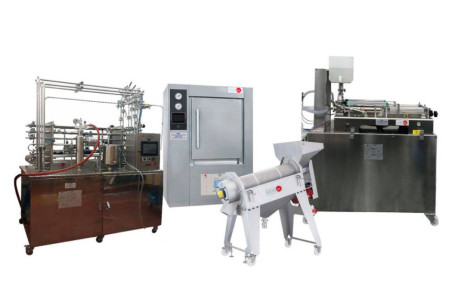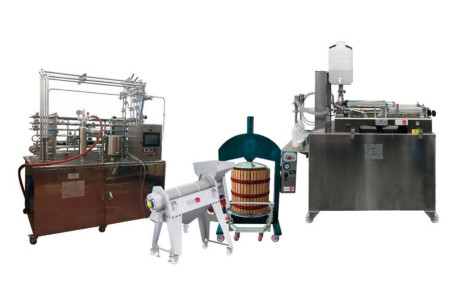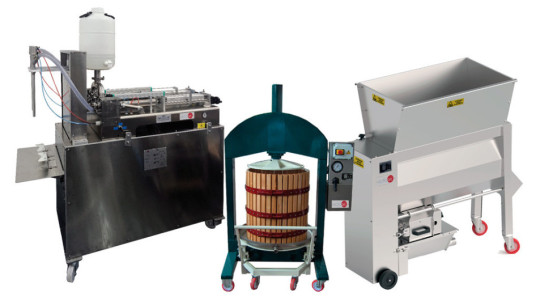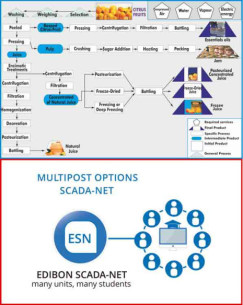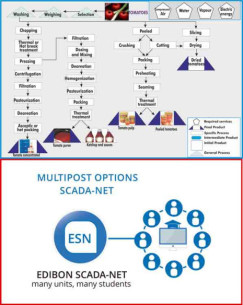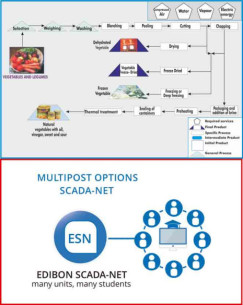The Pilot Plant for Fruit Essences Production, "FR00/FE", is a scale size pilot-plant equipped to carry out all industrial stages of essences fruit production.
In the production plant of essences, the process begins with the reception of fresh fruit, where a meticulous process of selection, washing and preparation of the fruit is carried out. To carry out these stages in the pilot plant, the following unit is included:
- WMFV. Washing Machine for Fruit and Vegetables. Fruit washing is essential to ensure hygiene and food safety. Its function is to remove any dirt, residue or surface contaminants from the fresh fruit, ensuring that it is clean and ready for processing. In addition, during this process, pieces of fruit that do not meet the quality standards for consumption are discarded. Once the selection is completed, the fruit is peeled if necessary, preparing it for the extraction of the fruit juice.
- FPCR. Fruit Pitting and Crushing Unit. Part of the fruit preparation includes pitting the fruit, however, this is not always necessary in the essence production process, depending on the type of fruit. This step is essential when the fruit contains large pits, such as mangoes, peaches, plums, etc. It is also highly recommended when cold extraction methods such as pressing or centrifuging are to be applied. This is because it facilitates the process and improves the extraction itself. On the other hand, pitting affects the texture and clarity of the essence, allowing to obtain a clearer and more filtered essence.
The following steps correspond to the cold extraction of the juice. This involves pressing, centrifuging and filtering the fruit pulp and juice. In the pressing process, two alternative units are available: the Sheet Press for Liquid Products Extraction, "SPLE" and the Hydraulic Press for Liquid Product Extraction, "HPLE". Therefore, the pilot plant includes one of the two pressing units mentioned above, depending on the type of pressing required.
- SPLE. Sheet Press for Liquid Products Extraction. The manual plate press is used to separate the juice from the pulp and solids of the treated fruit. Its manual operation allows a more precise control of the process and is ideal for smaller production batches.
- HPLE. Hydraulic Press for Liquid Product Extraction. Another way of pressing is the hydraulic press, which is a larger and more automated version of the manual press. It provides uniform and controlled pressure on the treated fruit, which facilitates efficient juice extraction and effective separation of solids.
The result of pressing is a concentrated liquid product free of large solid particles, which can be purified in subsequent stages. The extracted liquid is processed in a centrifuge, which clarifies the liquid, removing most of the residual particles.
- PJCM. Pulp and Juice Centrifugal Machine for Juices and Agri-food Products. This unit performs a crucial role in the process of extracting essences from fruits. The unit uses centrifugal force to separate solid particles present in the liquid, allowing the elimination of impurities and obtaining a cleaner and more transparent liquid. During this step, the centrifuge helps to remove pulp, pips, waste and other unwanted solids from the essence, thus improving its quality and visual appearance. In addition, by reducing the amount of suspended solids, it also avoids potential sedimentation problems and improves the stability of the final product. This results in a high quality product.
The liquid obtained is treated in a filter to remove the residual solids contained in the liquid, thus obtaining a clarified liquid.
- SFAF. Sheet Filter for Agri-food Liquid Products. The plate filter is essential to remove any remaining solid residue from the liquid, ensuring that the final product is clear and free of undesirable particles, which improves its clarity and organoleptic quality. This stage concludes the extraction of the essence from the fruit.
Once the fruit has been pressed and treated the product is concentrated in an evaporator. Once the essence has been extracted, it can be concentrated by removing the water contained in it, resulting in a more concentrated and potent essence.
- ECAL/CTS. Computer Controlled and Touch Screen Evaporator for Concentrating Agri-food Liquid Products. This stage involves the evaporator, which concentrates the liquid by the controlled removal of water, using heat, while retaining the aromatic compounds and essential flavors. The evaporator offers flexibility by adjusting the concentration according to the requirements of the final product and removes unwanted volatile compounds, improving the flavor and aroma of the essence of fruit. It also increases the shelf life of the essences.
Once the essence has been treated, condiments can be added or it can even be mixed with other essences. The homogenizer is responsible for performing this function, improving its flavor, texture or preservation.
- DMH/CTS. Computer Controlled and Touch Screen Milk Homogenizer. Ensures a uniform distribution of ingredients and a complete integration of flavors. In addition, it improves the quality of the final product, and can help stabilize the essence emulsion.
The filtered and treated product is bottled using a bottling and capping machines. The plant has two alternative bottling machines: the Computer Controlled Liquid Packaging Teaching Unit, "EDLC" and the Bottling Machine for Agri-food Liquid Product, "BMAF". Therefore, the pilot plant includes one of the two bottling units mentioned above, as required.
- EDLC. Computer Controlled Liquid Packaging Teaching Unit. This unit allows the product to be stored in containers suitable for transport and preservation, ensuring that they reach the final consumer with maximum quality and freshness. The Computer Controlled Liquid Packaging Teaching Unit, "EDLC", unit is a liquid and semi-dense products dosing machine based on dose delivery through a pneumatically-operated cylinder. The packer is responsible for filling the containers with the processed product in an efficient and sanitary manner.
- BMAF. Bottling Machine for Agroalimentary Liquid Products. An alternative to the previous unit is the Bottling Machine for Agroalimentary Liquid Products, "BMAF". This unit can only dose liquid products, as opposed to the possibility of bottling semi-dense "EDLC" products. Likewise, the bottling unit is responsible for filling the containers with the essence in an efficient and sanitary manner, guaranteeing the transportation and correct storage of the product.
Finally, the product is capped and sealed for its correct conservation in the following unit supplied.
- EDMT. Capping Machine for Agri-food Liquid Products. The capper is responsible for placing the hermetic caps on the essence-filled containers, ensuring that they are securely sealed and that the product is protected against contamination and oxidation. This unit together with the bottling machine ensures that the final product is ready for distribution and consumption, maintaining its freshness and quality.
Depending on the required production and the characteristics of the fruits to be treated there are recommended the following elements: Additional recommended elements (Not included):
If a high product flow is required, the use of a transit pump to pump and transport the intermediate products from the plant is recommended. The following unit can be considered for this application:
- TPAF. Transit Pump for Agri-food Products. This unit can be used with a wide variety of agri-food products and allows working in a wide range of flow rates.
Finally, during the whole production process, products and by-products are generated and can be stored in steel (not included) or polypropylene (not included) tanks suitable for working with agri-food products. The units that perform this function are:
- SSTAF. Stainless Steel Tank for Agri-food Products. Stainless steel tank designed for the storage of intermediate and final products in a plant. Its stainless steel construction ensures corrosion resistance and a hygienic surface. Its modular design and storage capacity make it ideal for efficient management of production processes.
- PTAF. Polyethylene Tank for Agri-food Products. Polypropylene tank designed for the storage of intermediate and final products in an industrial plant. Its polypropylene construction offers resistance to chemical corrosion and excellent durability, making it ideal for environments where agri-food substances are handled. Its lightweight and versatile design allows for easy installation and transport.
 Préférences sur les cookies
Préférences sur les cookies

